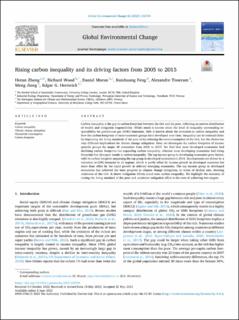| dc.contributor.author | Zheng, Heran | |
| dc.contributor.author | Wood, Richard John | |
| dc.contributor.author | Moran, Daniel Dean | |
| dc.contributor.author | Feng, Kuishuang | |
| dc.contributor.author | Tisserant, Alexandre Fabien Regis | |
| dc.contributor.author | Jiang, Meng | |
| dc.contributor.author | Hertwich, Edgar | |
| dc.date.accessioned | 2023-07-10T11:41:22Z | |
| dc.date.available | 2023-07-10T11:41:22Z | |
| dc.date.created | 2023-07-06T08:52:41Z | |
| dc.date.issued | 2023 | |
| dc.identifier.citation | Global Environmental Change. 2023, 82, 102704. | en_US |
| dc.identifier.issn | 0959-3780 | |
| dc.identifier.uri | https://hdl.handle.net/11250/3077471 | |
| dc.description.abstract | Carbon inequality is the gap in carbon footprints between the rich and the poor, reflecting an uneven distribution of wealth and mitigation responsibility. Whilst much is known about the level of inequality surrounding responsibility for greenhouse gas (GHG) emissions, little is known about the evolution in carbon inequality and how the carbon footprints of socio-economic groups have developed over time. Inequality can be reduced either by improving the living standards of the poor or by reducing the overconsumption of the rich, but the choice has very different implications for climate change mitigation. Here, we investigate the carbon footprints of income quintile groups for major 43 economies from 2005 to 2015. We find that most developed economies had declining carbon footprints but expanding carbon inequality, whereas most developing economies had rising footprints but divergent trends in carbon inequality. The top income group in developing economies grew fastest, with its carbon footprint surpassing the top group in developed economies in 2014. Developments are driven by a reduction in GHG intensity in all regions, which is partly offset by income growth in developed countries but more than offset by the rapid growth in selected emerging economies. The top income group in developed economies has achieved the least progress in climate change mitigation, in terms of decline rate, showing resistance of the rich. It shows mitigation efforts could raise carbon inequality. We highlight the necessity of raising the living standard of the poor and consistent mitigation effort is the core of achieving two targets. | en_US |
| dc.language.iso | eng | en_US |
| dc.rights | Navngivelse 4.0 Internasjonal | * |
| dc.rights.uri | http://creativecommons.org/licenses/by/4.0/deed.no | * |
| dc.title | Rising carbon inequality and its driving factors from 2005 to 2015 | en_US |
| dc.title.alternative | Rising carbon inequality and its driving factors from 2005 to 2015 | en_US |
| dc.type | Peer reviewed | en_US |
| dc.type | Journal article | en_US |
| dc.description.version | publishedVersion | en_US |
| dc.rights.holder | © 2023 The Author(s). Published by Elsevier Ltd. | en_US |
| dc.source.volume | 82 | en_US |
| dc.source.journal | Global Environmental Change | en_US |
| dc.identifier.doi | 10.1016/j.gloenvcha.2023.102704 | |
| dc.identifier.cristin | 2161117 | |
| dc.relation.project | Norges forskningsråd: 300330 | en_US |
| dc.relation.project | EC/H2020/821124 | en_US |
| dc.source.articlenumber | 102704 | en_US |
| cristin.ispublished | true | |
| cristin.fulltext | original | |
| cristin.qualitycode | 2 | |

